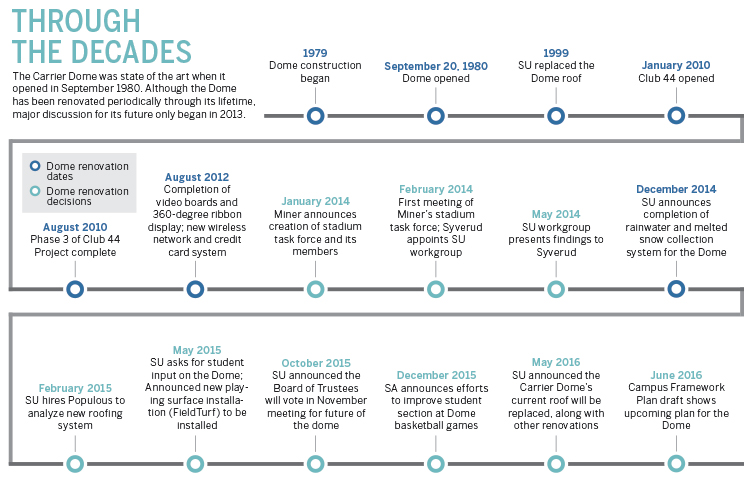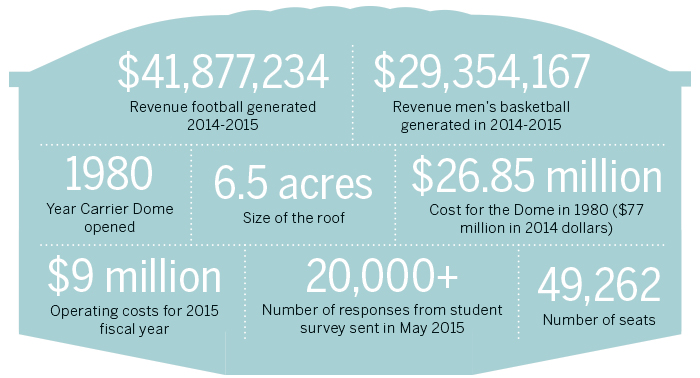An explanation of Syracuse University’s Carrier Dome renovations
Daily Orange File Photo
The Carrier Dome's aging roof will be replaced after months of discussion on the matter. This renovation will cost Syracuse University $105 million.
UPDATED: Sept. 25, 2017 at 9:07 p.m.
Perhaps nothing is more of a staple on the Syracuse University campus than the Carrier Dome. The Dome opened in 1980 and has since served as home for several Syracuse athletic teams.
But the Dome will soon be changing, as SU has announced renovations, including a roof replacement, to the stadium as part of the Campus Framework plan.
Lucy Naland | Senior Design Editor
What is the Carrier Dome?
The Carrier Dome is SU’s home for its football team, men’s and women’s basketball teams and men’s and women’s lacrosse teams. It is the largest domed stadium in the Northeast and one of the last major stadiums with an air-supported roof.
Why is there so much discussion about it?
When the Dome opened in 1980, it quickly uplifted a struggling city and lackluster football program, drawing record numbers of fans to games. The Dome became a well-known backdrop for Syracuse basketball and football games. But eventually it became evident the aging 33-year-old stadium — once state of the art — would need renovations if SU chose to continue using it as its home stadium.
Faculty and staff expressed their concerns over Dome renovations — mirroring past worries faculty and staff had over construction of the Dome in the late 1970s — that the university would neglect allocating resources to academics in favor of athletics.
A University Senate report from 1979 read, “Faculty and students are especially anxious that the new dome not drain money from the traditional university budget.”
Current professor of geography Thomas Perreault said in an October 2016 interview with The Daily Orange that he likes the idea of renovations, but that the upgrades weren’t part of the university’s core mission.
Faculty and staff were not alone in opposing the Dome’s construction in the 1970s. Before the Dome was built in its current location, it was slated to be built on Skytop field. Residents lay down in the dirt on the day construction was supposed to begin at the Skytop site in protest of having the Dome in their neighborhood and disrupting traffic.
The university invested in many renovations throughout the 2000s, including a new playing terrain, an exclusive club in the Dome called Club 44, video boards and 360-degree ribbon display, upgraded wireless networks and credit card system and a rainwater collection system. But the main issue was always the roof.
The fabric used to cover the roof would eventually deteriorate. Additionally, heavy snow could potentially deflate it. SU already replaced the roof as a precaution in 1999, 19 years after the stadium opened. The new roof was made of stronger fabric and was supposed to last 30 years, or until 2029.
A proposal for a new off-campus stadium began circulating in late 2013, although a private developer had contacted the university as early as 2007. Onondaga County Executive Joanie Mahoney had convinced New York state Gov. Andrew Cuomo to provide as much as $200 million of a $500 million project to create a new stadium, according to Syracuse.com.
However, Mahoney failed to convince Syracuse Mayor Stephanie Miner to endorse the stadium and abandoned the proposal in early 2014. Miner said she did not hear of the proposal until December 2013, and wanted more information, such as funding, location and effect on city services like traffic. In her 2014 State of the City Address, Miner announced the creation of a stadium task force to research the possibility of a new stadium.
Miner’s 24-member stadium task force included SU Chancellor Kent Syverud, along with Mahoney, Cuomo, state Sen. John DeFrancisco and then-interim Upstate Medical University President Gregory Eastwood.
However, Syverud decided not to appoint anyone to serve on Miner’s task force and instead announced SU would complete its own internal analysis for the Dome. Syverud’s five-member task force was created to develop solutions in case the Dome became unusable due to roof failure.
The committee presented its finding in May 2014. John Yinger, a trustee professor of public administration and economics and a member of the committee, said no facility besides the Dome could hold a basketball game for the 24,000 SU basketball season ticket holders. The committee explored various problems that could potentially cause an inoperable Dome, including electrical failure, chemical spills and roof failure, which was the most likely to occur.
What’s going to happen to it?
The university examined three possible solutions for the Dome: replacing the current, air-supported roof; installing a new roof system and making other renovations; or building a new off-campus stadium.
In January 2015, Rick Burton, David B. Falk College of Sport and Human Dynamics distinguished professor of sport management and chair of Syverud’s task force, said it would cost about $25 million to replace the current air-supported roof. It would likely need to happen in the next six to eight years — more than six years earlier than the supposed 30-year lifespan of the roof, he said.
The proposed off-campus stadium would have been built in Kennedy Square, a five-minute drive from the SU campus. It would have a retractable roof and 44,000 seats — a homage to SU’s relationship with the number 44 — and cost $495 million. It would take approximately four years for the stadium to be built and operating.
But in January 2015, a year after Miner’s task force was created, all talks of a new stadium had virtually died out. The money to build the new stadium was no longer available, Syracuse Common Councilor Kathleen Joy said at the time.
A month later the university hired Populous, an outside consultant, to research options for a new fixed roof for the Dome.
In May 2015, SU released a student survey about the Dome, asking about the fan experience, the facility itself and level of support for various funding options.
In October 2015, the university announced the Board of Trustees would vote at its November meeting on the future of the Dome. By March 2016, however, the Dome was still “being assessed.”
The university announced in May 2016 it will replace the Carrier Dome’s air-supported roof with a new fixed roof, along with other renovations. The new roof will cost $105 million. With the $50 million overhaul of Archbold Gymnasium to become “The Arch” and $100 million Americans with Disabilities Act accessibility and mobility upgrades in both the Dome and Archbold, the total cost will be $255 million. Kevin Quinn, senior vice president of public affairs, said at the time there was no timeline for the replacement of the Dome roof.
Lucy Naland | Senior Design Editor
Has SU been accurate on its timelines for Dome renovations?
The university has generally kept to its timelines for Dome renovations. In January 2015, Quinn said the university had about two years to make a decision on the Dome. In October 2015, Syverud said the university hoped to have a decision made by the end of the school year, and the decision was announced in May 2016.
When the university announced the Dome would start harvesting rainwater to flush Dome toilets and urinals in January 2013, construction was to begin in May 2014 and be completed two months later. But construction was actually finished in December 2014.
When the construction was completed, Pete Sala, vice president and chief facilities officer, said the rainwater system initially had a tentative completion date of Oct. 31, 2014, but custom-made parts were needed and the project had to be delayed.
In 2012, new video boards and a 360-degree ribbon display were announced in June and completed on schedule in August.
Will the Dome’s roof be replaced?
Though Sala said the university was in a “good place” when it came to finding a plan for the Carrier Dome roof in September 2016, those renovation plans are still unclear. Sala said at that time that the goal was to build a new roof over the old roof, but that the repair plans were still “very conceptual.”
Sala said in February this year that the renovations were still in the planning stages and mentioned the possibility of a glass “bump out” addition to the exterior of the Dome from last September.
The university provided no information on a timeline for the Dome in the latest Campus Framework draft released in June 2017. Sala said the university will try to ensure construction doesn’t force athletic teams to move out or affect campus events such as commencement.
How does the Dome fit into the Campus Framework plan?
The Dome is part of the West Campus Project under the Campus Framework, one of three components in Syverud’s Fast Forward Syracuse initiative. The Campus Framework focuses specifically on SU’s physical campus over the next 20 years.
In June 2016, the 42-page draft of the Campus Framework was released. According to the document, the Dome will receive “a new fixed roof leveraging premier cutting-edge technology” and ADA-related accessibility and mobility upgrades.
Archbold will also undergo upgrades and become “The Arch,” a new health and wellness complex. In May, Andrew Elmer from Populous announced the four levels of the new complex: the basement would be a multi-purpose group space; the ground floor would have two pools, an exercise gym and pharmacy; the third level would have four basketball courts; and the fourth level a track and cardio balcony.
The Daily Orange will continue to update this Explainer as new information about the Campus Framework is released.
CORRECTION: In a previous version of this article, the age of the Carrier Dome was misstated. The Carrier Dome is 36 years old. The Daily Orange regrets this error.
Disclaimer: The Daily Orange leases a house on Ostrom Avenue owned by Syracuse University. As part of the Campus Framework, the university has proposed building student housing on Ostrom Avenue where The Daily Orange currently operates.
Published on July 10, 2016 at 1:19 pm
Contact Kennedy: krose100@syr.edu | @KennedyRose001







